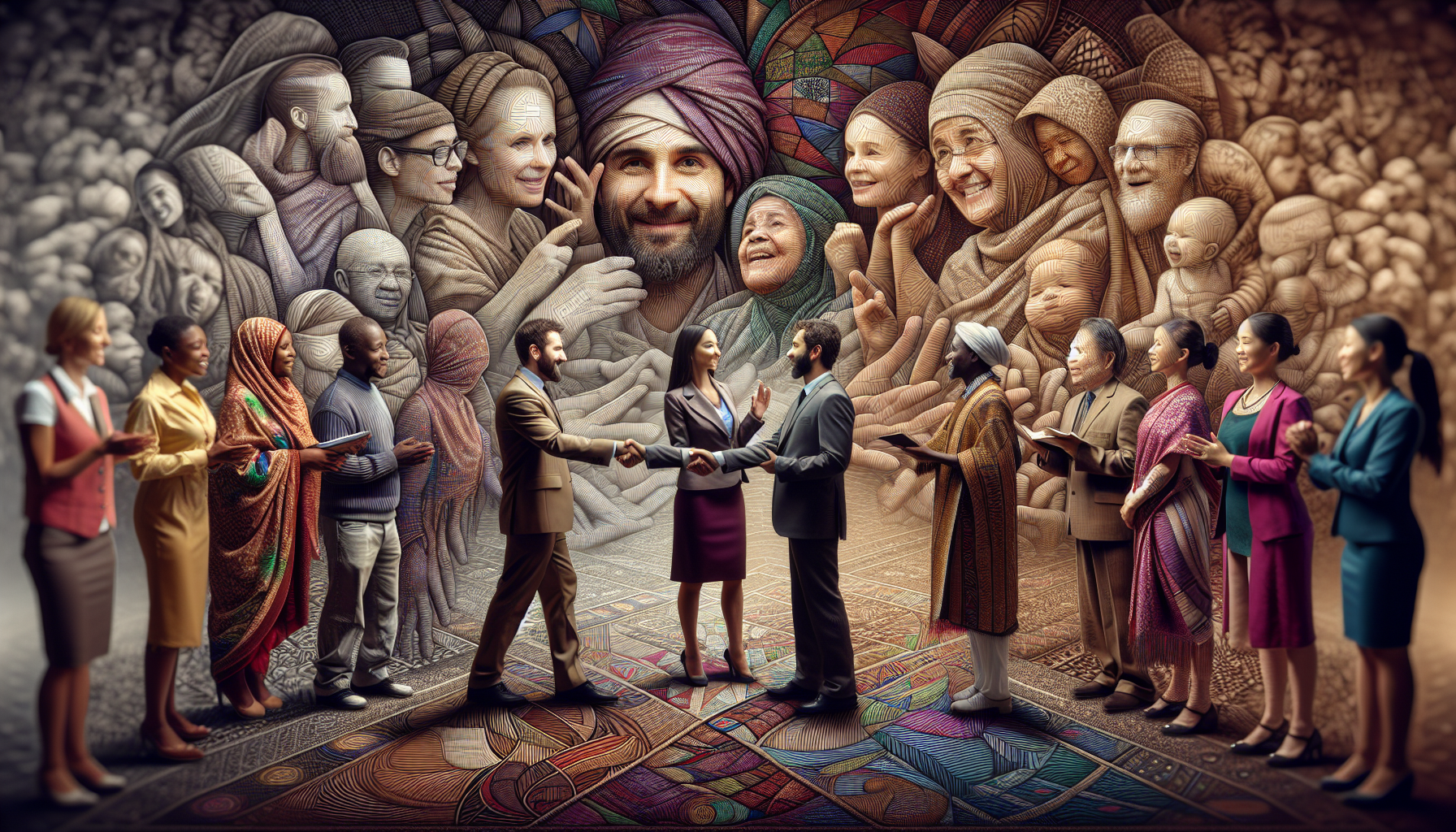Visiting religious sites around the globe is a deeply enriching experience that offers insights into the diverse tapestry of faith and culture. This course is designed to guide travelers on how to dress appropriately for such visits, providing practical advice, cultural sensitivity tips, and solutions to ensure respectful and meaningful interactions. Covering essential themes like understanding the importance of dress codes, navigating religious dress codes with dos and don’ts, and offering practical advice for travelers, this course aims to prepare individuals for an immersive cultural journey while respecting the sacred spaces they explore.
Lesson 1

Understanding the Importance of Dress Codes in Religious Spaces
In the world of travel and cultural exploration, respecting dress codes at religious sites is a fundamental aspect. This practice not only demonstrates respect for local customs and beliefs but also enriches the visitor’s experience. Understanding the importance of dress codes in religious spaces is crucial for anyone looking to embrace the fullness of cultural immersion.
Why Dress Codes Matter in Sacred Spaces
Religious spaces often carry deep spiritual significance for their communities. These places are not just architectural marvels; they are sacred grounds that hold history, faith, and traditions. Thus, wearing appropriate attire isn’t just about following rules—it’s about showing reverence and sensitivity towards another culture’s sacred values. Moreover, appropriate dress helps in fostering an atmosphere of respect and solemnity, essential in these spiritual spaces.
Common Dress Code Expectations Across Religions
- Modesty: Covering shoulders, knees, and sometimes heads is a common requirement.
- Specific attire: Certain religions may require specific colors or types of clothing.
- Removal of shoes: In many cultures, visitors must remove their shoes before entering a sacred space.
The Impact of Clothing on Expression of Respect
Dressing appropriately for religious sites goes beyond mere compliance with guidelines; it’s a powerful way of expressing respect and empathy towards a community’s beliefs and practices. It communicates openness and willingness to understand, attributes crucial for meaningful intercultural exchanges. Thus, the clothes we choose to wear in such contexts can significantly impact our interactions and the perceptions others have of us.
Case Studies: Dress Codes in Action
Let’s consider a few examples:
| Location | Religion | Dress Code Requirement |
|---|---|---|
| St. Peter’s Basilica, Vatican City | Christianity | Shoulders and knees covered, no hats for men |
| The Golden Temple, India | Sikhism | Headscarves for both genders, remove shoes |
| The Grand Mosque, UAE | Islam | Loose clothing covering all parts of the body, headscarves for women |
In conclusion, understanding and adhering to dress codes when visiting religious sites is a crucial part of traveling responsibly and respectfully. It’s about more than just following rules; it’s a gesture of respect towards the local culture and religion, ensuring a more meaningful and enriching experience for all involved.
Lesson 2

Navigating Religious Dress Codes: Dos and Don’ts
When visiting religious sites, it’s crucial to adhere to dress codes out of respect for the local culture and beliefs. Navigating these dress codes effectively ensures a respectful and enriching experience. Let’s dive into the dos and don’ts of dressing appropriately for religious sites, highlighting the importance of understanding and honoring these sacred practices.
Dress Code Rules for Major World Religions
Each religion has its own set of guidelines for appropriate attire when entering places of worship or sacred sites. It is essential to familiarize yourself with these norms before visiting to ensure respectful compliance.
- Christianity: Modest clothing, with shoulders and knees covered.
- Islam: Loose-fitting clothes covering most of the body; headscarves for women.
- Hinduism: Conservative attire; shoulders and knees covered; shoes off before entering temples.
- Buddhism: Modest clothing similar to Hinduism; respectful colors like white.
- Judaism: Conservative dress; men may need to wear a head covering.
Universal Dos in Religious Dress Codes
Regardless of the specific religion, certain universal dos apply across the board. These include dressing modestly, covering shoulders and knees, and showing general respect through your choice of attire.
Universal Don’ts in Religious Dress Codes
Just as there are universal dos, there are also universal don’ts. These typically involve avoiding shorts and sleeveless tops, loud or flashy clothing, and inappropriate shoes.
Tips on Researching and Preparing for Your Visit
Preparation is key to ensuring you meet the dress code requirements of any religious site you plan to visit. Utilize resources like travel blogs, official site guidelines, and cultural forums to gather information.
| Religion | Do | Don’t |
|---|---|---|
| Christianity | Cover shoulders and knees | Wear shorts |
| Islam | Wear loose-fitting clothes, headscarves for women | Expose arms or legs |
| Hinduism | Remove shoes before entering temples | Wear revealing attire |
In conclusion, understanding and following the dress codes for religious sites is an integral part of visiting these sacred spaces. It demonstrates respect and sensitivity towards the local culture and beliefs, ensuring a positive and enriching experience for all. Remember, the key to navigating these dress codes is preparation, respect, and a willingness to embrace the cultural practices of the places you visit.
Lesson 3

Practical Advice and Solutions for Travelers
Visiting religious sites is a profound experience that offers deep insight into the Heart and soul of different cultures. To ensure this experience is as respectful and enriching as possible, travelers should carefully consider their attire. This guide provides practical advice and solutions for dressing appropriately when visiting religious sites, ensuring travelers can navigate these sacred spaces with respect and sensitivity.
Packing and Preparing for Trips Involving Religious Sites
Preparation is key to a seamless visit. Start by researching the specific dress code guidelines of the religious sites you plan to visit. This may influence what you decide to pack. Opt for versatile pieces that can be easily adapted to various dress code requirements. For instance, lightweight long-sleeve tops and scarves can be invaluable for covering shoulders and heads where required.
- Lightweight, modest clothing that can be layered
- Scarves or shawls for covering heads and shoulders
- Comfortable, easy-to-remove footwear
Creative Solutions for On-the-Go Adjustments
Even with the best preparation, you may find yourself in need of making quick adjustments. Keeping a lightweight scarf or shawl in your daypack is a simple yet effective way to adapt your attire for an unexpected visit to a religious site. Such items can also add a respectful touch even when not strictly required, showcasing your consideration for local customs.
Handling Situations Where Appropriate Attire Isn’t Available
In some cases, visitors may be caught off guard and find themselves without the required attire. Many religious sites are accommodating and may provide or rent garments like sarongs or head coverings to ensure visitors can still enter. Don’t hesitate to ask for such amenities, as it reflects your willingness to comply with local traditions.
Encouraging Open-Mindedness and Empathy
Ultimately, dressing appropriately for religious sites is about showing respect for the beliefs and practices of the local community. It is an opportunity to learn and broaden one’s perspective. By approaching these experiences with open-mindedness and empathy, travelers not only respect the cultures they visit but also enrich their own understanding of the world.
| Item | Purpose | Benefits |
|---|---|---|
| Lightweight scarf | Covering shoulders or head | Versatile, respectful, stylish |
| Easy-to-remove shoes | Entering places requiring no shoes | Convenience, respect |
| Long-sleeve tops | Covering arms in conservative sites | Comfort, adaptation to various sites |
In summary, dressing appropriately for religious sites is an essential aspect of travel etiquette. By planning ahead and being prepared to adapt, travelers can ensure that their visits to these sacred spaces are respectful and enriching experiences. Remember, embracing local customs with open-mindedness and empathy not only shows respect but also enhances your journey, bridging connections with the cultures you encounter.
Visiting religious sites is an invaluable part of global travel, enriching one’s understanding of diverse cultures and beliefs. This course has equipped you with the knowledge to navigate dress codes sensitively and respectfully, ensuring your experiences are both profound and respectful. Now, it’s time to put what you’ve learned to the test. Below, you’ll find a 10 question quiz designed to test your knowledge and ensure you’re fully prepared for your next visit to any religious site worldwide. Tackling this quiz is not only a great way to reinforce what you’ve learned but also an essential step in your journey toward being a more culturally sensitive and respectful traveler.
Test Your Knowledge With this short Quiz
Click here to copy your score to share on facebook!







